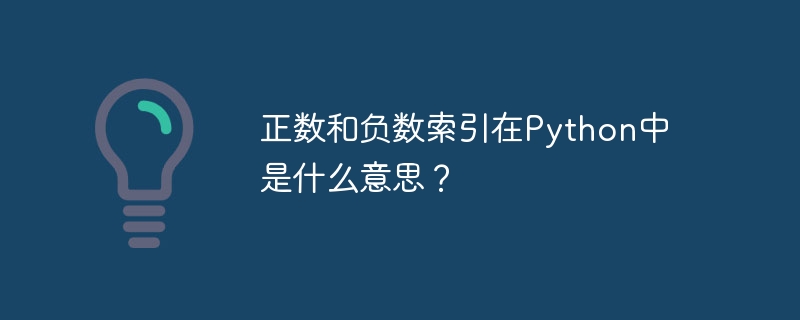
通过索引,我们可以访问Python序列数据类型中的项目。字符串、列表、元组和范围对象都是序列数据类型。在本教程中,我们将详细介绍索引。
任何编程语言中的线性数据结构都是围绕索引构建的。每台机器的默认索引从0开始,一直到n-1。在这种情况下,n表示相应数据结构中的总项目数。类型包括
Positive indexing − Increases from 0 to 1.
Negative indexing − each traversal moves from tail to head, starting with the last element.
立即学习“Python免费学习笔记(深入)”;
These facilitate our ability to access the many components of this data structure. Let's examine the procedures in the next part.
类似于我们如何访问列表和字符串中的元素,我们也可以访问元组中的元素。因此,索引和切片是我们访问元素所需的唯一方法。此外,索引是直观的,从索引零开始,就像列表一样。此外,我们在方括号中放置的数字表示元组的索引。让我们看一些使用元组索引来检索元组元素的示例。
tup1 = (10, 3, 4, 22, 1) # for accessing the first element of the tuple print(tup1[0])
10
tup1 = (10, 3, 4, 22, 1) # accessing the third element of the tuple print(tup1[2])
4
tup1 = (10, 3, 4, 22, 1) print(tup1[10]) # gives an error as the index is only up to 4
IndexError: tuple index out of range
tup1 = (10, 3, 4, 22, 1) print(tup1[1+3]) # the expression inside the square brackets results in an integer index 4. Hence, we get the element at the 4th index.
1
In Python, positive zero-based indexing is the fundamental method for accessing iterable items.
As a result, an index starting at 0 may refer to any element in the iterable.
第一个以零为基准的索引元素的索引为0,第二个为1,依此类推。
myList = [1, 2, 3, 4, 5] # NORMAL INDEXING print(myList[0]) print(myList[1]) print(myList[2]) # NEGATIVE INDEXING (STARTS FROM THE LAST ELEMENT IN THE LIST) print(myList[-1]) print(myList[-2]) print(myList[-3]) print(myList[-3:])
1 2 3 5 4 3 [3, 4, 5]
If we wish to print the components starting at the end, we may also use negative indexes. Additionally, by specifying the index number with a negative sign, we may carry out negative tuple indexing (-). As a result, this suggests that the compiler starts thinking about the elements in reverse order, beginning with the element that comes last in the tuple.
tup = (22, 3, 45, 4, 2.4, 2, 56, 890, 1) print(tup[-4])
2
Now, we can use negative indexes in slicing also.
tup = (22, 3, 45, 4, 2.4, 2, 56, 890, 1) print(tup[-4:-1])
(2, 56, 890)
The tuple index() function aids in locating an element's index or location within a tuple. Essentially, this function serves two purposes −
Giving the tuple's first instance of each element.
If the indicated element is absent from the tuple, throwing an error.
tuple.index(value)
使用pop()函数并将-1作为参数传递给它,我们可以删除该列表的最后一个元素,并获得一个新列表。
my_list = [45, 5, 33, 1, -9, 8, 76] my_list.pop(-1) print(my_list)
[45, 5, 33, 1, -9, 8]
tup = (22, 3, 45, 4, 2.4, 2, 56, 890, 1) print(tup.index(45)) print(tup.index(890)) #prints the index of elements 45 and 890
2 7
需要更少的代码行数,并且可以在一行中完成反转。
Simplifies difficult processes.
在要求很少复杂性的情况下快速运行
总之,Python允许从零开始进行正向索引和从-1开始进行负向索引。在Python中,负向索引表示索引过程从可迭代对象的末尾开始。最后一个元素位于索引-1,倒数第二个元素位于索引-2,依此类推。负向索引在Python计算机语言中支持数组,但在大多数其他编程语言中不支持。这意味着索引值-1提供了数组的最后一个元素,-2提供了倒数第二个元素。负向索引开始的地方是数组的末尾。
(2, 56, 890)以上就是正数和负数索引在Python中是什么意思?的详细内容,更多请关注php中文网其它相关文章!

python怎么学习?python怎么入门?python在哪学?python怎么学才快?不用担心,这里为大家提供了python速学教程(入门到精通),有需要的小伙伴保存下载就能学习啦!

Copyright 2014-2025 https://www.php.cn/ All Rights Reserved | php.cn | 湘ICP备2023035733号